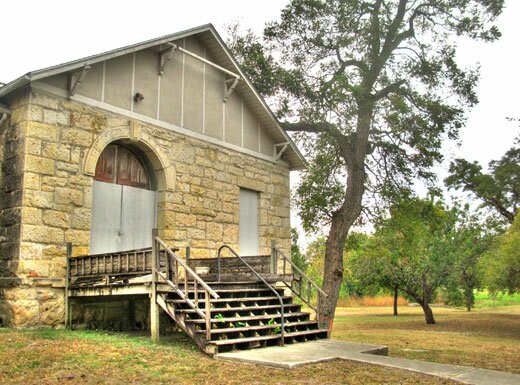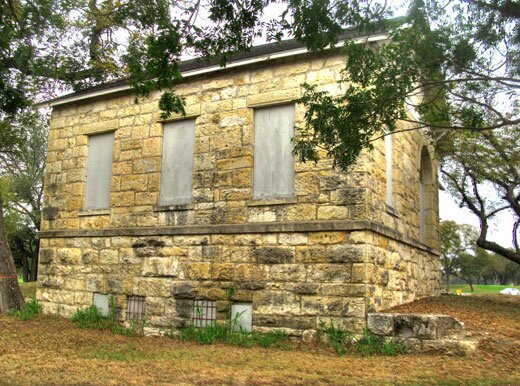Gene Elder, Gutzon Borglum, The Alamo, and the MUD Underground. or “IF ITS NOT THE ALAMO, then its just a studio”
Posted by justin on 26 Nov 2008 at 07:01 pm | Tagged as: adventure day, architecture, art + bikes, art paparazzi, arts organizations


(Words by Gene Elder)
(Photos of Gutzon Borglum studio by Justin Parr)
(The following article is from CATCH-UP, a one issue art magazine that a group of San Antonio artists published in May of 1978.
I chose to write an article about Gutzon Borglum and his abandoned studio on the San Antonio River. It is an interesting history. Artists will find these facts important, as I did.
In 1978 we were protesting the lack of support for the arts. The abandoned studio of Gutzon Borglum where he created the model for Mt. Rushmore symbolized that lack of interest in the arts and the neglect of the creative community.)
IF ITS NOT THE ALAMO, then its just a studio
by Gene Elde_______________r
It has been my philosophy for some time now, that if you want to really enjoy an art exhibit, ignore the artist and the curator and go straight to the janitor. I have found that talking with the soul who picks up the trash after openings and daily sweeps the floors, empties ashtrays, polishes furniture and cleans the restrooms has the more interesting view of the arts. So with this in mind, I sat one Sunday on the steps of the Brackenridge Park Pumphouse and asked for wisdom from the Caretaker of the studio of Gutzon de la Mothe Borglum (The creator of Mount Rushmore.)
INNER VIEW:
There has not been a caretaker here in 10 years… people have forgotten this artistic heritage … but then perhaps that is the responsibility of a good studio, to remember the things that were created here and not to tell everything it knows.
But this studio told me that many times Gutzon sat here in ecstasy; thinking about the monument that would lift the hearts of America long after he had gone … (an artist learns that nothing is ever really his, only his to leave behind.)
Some of the time Gutzon sat here depressed and disenchanted from all the delays … but he understood that too. An artist is a servant as well as a leader and sometimes he must be both alone.
Many thought he was a little crazy … then again… most did not see the world the way Gutzon did.
This fateful studio, a two-story stone building near the Brackenridge golf course, was originally constructed under the supervision of George Washington Brackenridge in the mid-1880s. It served as the second pumphouse for the San Antonio Waterworks Co. until 1915 when it was abandoned. The pumphouse stood at the end of a long power canal which carried water to power turbines connected to a pump with a capacity of three million gallons daily. The water was lifted to the eastern end of Mahncke Park and in 1897 steam power was added to the station.
Gutzon moved to the abandoned pumphouse in 1924, using it as a studio for 13 years.
Now that the hor d’oeuvres have been served, to whet our appetite, shall we share a salad with our famous homemade house dressing?
While reading a book titled Unfinished Dream, by June Zeither and Lincoln Borglum, I enjoyed learning these things and have chronologically and alphabetically tossed them into the salad section.
Research revealed this famous South Dakota mountain site is named after a young New York attorney named Rushmore who was doing legal work for a mining company. When he asked the name of the peak, his companions answered lightly, “Hanged if we know! Lets call the damned thing Rushmore.”
Gutzon’s first model, completed in his winter studio in Brackenridge Park, was of three figures.
Washington: Since he represented the birth of the nation and the noble spirit which started a courageous people on an untried course.
Jefferson: To show the inspiration of the Declaration of Independence along with the foresight of the Louisiana purchase which expanded our country.
Lincoln: Representing the humanity, the suffering, the compassion, and the eternal unity of the nation.
When Roosevelt was chosen it brought forth a flood of controversy. Calvin Coolidge agreed with Gutzon that Roosevelt would properly round out this saga in stone. His enthusiasm for the American West, his efforts in behalf of labor along with the building of the Panama Canal, proclaimed Roosevelt to be the logical choice. To Gutzon this choice was right. “Regardless of what biased people may think of these four human beings, they were the ones who personified certain basic elements, crucial to our survival and growth as a nation.”
Not only was the choice of Roosevelt an issue, Gutzon’s angels commissioned by the Belmont Chapel of the Cathedral of St. John the Divine in New York City erupted into a nationwide controversy. The ecclesiastical hierarchy rejected the models on the grounds they appeared too feminine. “Angels,” they declared, “are masculine.”
Gutzon’s statue of Atlas bearing the weight of the world shocked the conservative. Delighting in this controversy, because “Atlas” turned out to be a woman, the sculptor explained that only woman has the strength and endurance for such a weight.
There was also a conflict with the Daughters of the Confederacy over Stone Mountain which ended with Gutzon destroying his clay models. They raised a furious cry and demanded the immediate arrest of the fleeing sculptor. Gutzon escaped into North Carolina with the law of Georgia hot on his heels. North Carolina’s Governor McLean announced he would call out the militia to protect the sculptor.
Besides being a sculptor, Gutzon served as a chairman of Central Park in New York and gave his thoughts to help San Antonio keep its historic Missions and meandering river. He also worked out an ambitious plan to beautify the entire state of Texas.
He gave a strong speech before the first National Arts Committee urging the government to promote a cultural consciousness in America. He felt that the government should scout out potential artist, but should never try to guide or mold the arts.
Gutzon’s plan for world peace was one of 20 selected for the Edward Bok American Peace Award for writers.
He regularly wrote “Letters to the Editor” delighting readers from coast to coast. They were well written, to the point, attention getting, and presented the unknown side of controversial issues.
Lincoln Borglum described his father as “a man of medium height, stocky build, and exceptionally broad shoulders. He had brown hair and piercing blue eyes. His cheeks were broad, his jaw square, and his chin determined. He was seldom seen without a brisk felt hat, which covered his balding head. His clothing was somewhat of a hybrid between that of an imaginative artist and a western bank president.”
Thrift, strict budgets, or bookkeeping were not necessary parts of Gutzon’s life. “Many times his commissions barely paid for the cost of his supplies, and often he would donate an important work, or turn part of his money back to the organization that commissioned him.”
Mount Rushmore took 16 years of his life. He died in debt, and his son, Lincoln, had to beg the government to pay Mary, Gutzon’s wife, the rest of the fees due Gutzon at his death.
Does
This
Ring
A
Bell
as we engage on an entree where it is
considered in bad taste to request
catsup ?
In 1937, Gutzon left his studio to the Witte Museum, where it was used for the Museum School of Art. This group eventually merged with the Art Institute, started by Marion Koogler McNay. Rumor revealed Etienne Ret, a French portrait painter invited here by Mrs. McNay to teach, worked in Gutzon’s studio. With these events a tradition was born. The tradition of handing down a studio. There were others who worked here before it closed in 1960; Max Fitzpatrick, Chester Tony, Jack Fletcher, and Dan Withers. Since then, various attempts have been made to utilize the building. Julie Black proposed a pottery studio in 1976, but the most recent renovation plan was prepared by Rudy Trevino. Today, after 18 years, we are slowly beginning to gather together at it’s cemented windows and locked door to re-call it’s role as contained in the words of Etienne Ret: “Perhaps I will not come back to teach, but I will come back, yes. San Antonio is after all one of the few cities where you can live life as it should be lived.”
Now there is a pleasant golf course with golfers walking and talking with the crew that maintains the lawns … joggers pass occasionally … people visit, even if only to ask questions about the pumphouse. But the community needs this place to be filled with artists again. It should be used as a meeting house by all the artists in San Antonio. Gutzon would like that.
Time has again brought us here to unlock The Studio doors. Not only the future, but now we know, the choice is to hear the knock or to ignore.
A Fortune Cookie,
begins our next course.
_____________________
CON SAFOS
_____________________
It’s so groovy people have copies of Catch-Up around. Thanks for finding and republishing a piece. 1978 was a wonderful time in San Antonio. Con safos, indeed!
Very great writing! Really!